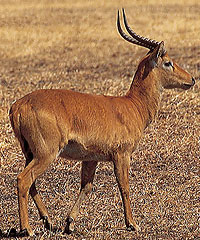 |
| Language | Name |
| Afrikaans | Poekoe |
| Tswana | Puku |
|
|
|
|
Slightly larger than impala, puku (a Tswana word), were first collected in Zambia along the Zambezi river by David Livingstone in 1857. Puku stand at an average height of between 90 to 100cm at the shoulder. Rams have a mass of between 70 and 75kg, while ewes are slightly lighter averaging between 60 and 65kg. The upper parts of this medium-size ram are golden-yellow in coloration. Underparts, throat, sides of the muzzle and around the eyes are white to off-white. The legs are a uniform brown colour. The male carries a set of short, stout lyra-shaped horns which are well-ringed almost all the way to the tips.
Restricted in the subregion to northeastern Botswana (Pookoo Flats/Chobe river), southwest Zambia, northeast Angola, southeast Congo and southern Tanzania.
Prefers open flatlands and marshes close to rivers, utilising the narrow stretches of grassland lying between these areas.
Puku are gregarious and occur in small herds numbering between 5 and 30 individuals. These herds are not static and numbers will often change as animals come and go.
Female herds comprise adult ewes and juvenile females which will move through the territories of several territorial males. As this happens, males attempt to herd females in oestrus, keeping them within their own territory. These territories are maintained for periods ranging from a few days to several months.
Puku are most active during the twilights hours of dawn and dusk.
Predominantly grass eaters.
Births occur throughout the year with a distinct peak during winter months. Gestation takes approximately 240 days. Lambs form loose associations with two or three other animals, the mother/lamb bond is weak in comparison with other antelope species.
|